Lisa Dawn's Blog: The Princess Blog, page 49
January 15, 2021
Review: Disenchantment - Part 3
I have a lot of mixed feelings about Disenchantment. I love the concept of a fantasy princess show from , creator of The Simpsons and Futurama, which both have deeply flawed protagonists that people would not associate with the heroes or heroines from fairy tales. Bean is a new kind of princess who is more likely to hang out at the local tavern instead of attending a royal ball. Her two sidekicks, Elfo, a lovesick runaway elf and Luci, a demon who was kicked out of Hell, give the show plenty of humor and charm. The biggest flaw derives from its format. The Simpsons and Futurama were long-running episodic series that pumped out a lot of episodes that could be watched in any order with the intention of being syndicated on network television. Netflix series are designed to be binged, which means they release small chunks of episodes that give enough of a cohesive story to satisfy viewers for another year while they wait for the next season. So far, Disenchantment has failed to tell a satisfying story in any of its first three seasons and instead gives us three piles of filler episodes that lead up to a tantalizing teaser for the next season that never lives up to the hype.
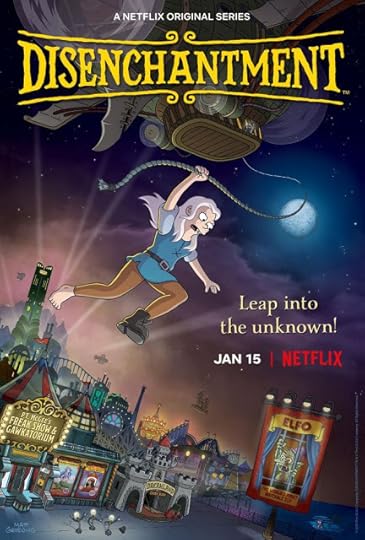
The third season of Disenchantment is a slog of a binge. I found it difficult to pay attention to the thinly linked episodes because nothing that happened seemed to matter in the grand scheme of things. I was hoping that this season would focus more on Bean's relationship with her mother, but Queen Dagmar was only in it marginally more than the previous season. Most of the episodes expanded on more of Bean's zany adventures running through the fantastical kingdoms of her world with Elfo and Luci. It seemed like they were always trying to get away from someone, but it was difficult to keep track of who or why, which made me less invested in the chase. Her brother, Prince Derek, had five minutes of character growth involving a unicorn and a saggy faery, which was nice, but it felt so unnecessarily rushed and mixed in with irrelevant gags that didn't help move the story or build the world. One highlight of the season was Bean's whirlwind romance with Mora the Mermaid, revealing her orientation as a queer princess.
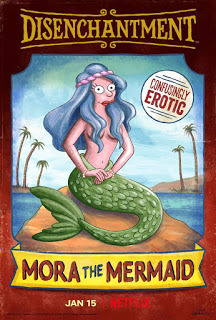
Woven beneath this season's wacky exterior is an underlying theme of loneliness. Its plot inconsistencies are compensated by this consistent theme. Every character struggles with a desire to be loved. This theme was most prevalent with Bean's father, King Zog, who is literally buried alive at the beginning of the season. When he escapes, he struggles with severe mental illness, which is treated as a joke with dark undertones. Zog suffers a great deal of trauma and loneliness throughout the season until he is reunited with Bean, who is determined to not give up on him. Bean has always been a lonely outcast, but her desire for love is emphasized even more by the tragic brevity of her romance with Mora the Mermaid. Elfo takes a break from his pining over Bean to seek out a relationship with a fortune telling head he meets at a freak show, which ends in tragedy as well. In the end, Bean and her friends begrudgingly come to terms with the fact that they are doomed to never find a deeper relationship than the one that they share with each other.
The biggest contributor to the problems with this season is its lack of a consistent villain. Every episode seems to have a new bad guy. While that would work fine for a Saturday morning cartoon from the '90s, it makes it difficult to enjoy of for a 10-episode arc. I didn't even have time to figure out Queen Dagmar's goal in kidnapping Bean during the first episode before Bean escapes and encounteres a new threat. By the time she tracsd down the wicked Arch Druidess in Steamland, it turns out someone else might have been the true threat, but she runs away from there before we could determine exactly how. In order for this show to be a true success, it should have a single villain with a clear motive. If it were up to me, that villain would be Dagmar to allow more time for Bean to explore her messed up relationship with her mother.
Overall, this season was a miss for me. It suffers from the same problems as the other two and ends just when things start to get interesting yet again. They've already played this trick on me twice before, and I'm over it. I'm sick of being strung along with the implication that something big is about to happen only to wash, rinse, and repeat another set of filler episodes. I am sad to say that after three seasons, Disenchantment has failed to reach same the level of character growth or worldbuilding as Futurama. The teasers for the next season look amazing, but after the way this one turned out, I will be entering it with a healthy amount of skepticism.
January 10, 2021
Review: The Opal Crown
Last week, I reviewed an unnecessary sequel, so it only feels appropriate to follow up with another sequel I read that is so necessary that the original book feels empty without it. The Opal Crown by Jenny Lundquist fills in all of the gaps that were left behind by the Princess and the Pauper-inspired book, The Princess in the Opal Mask. I enjoyed The Princess in the Opal Mask, but was left with many questions after completing the final chapter. It leaves both girls in a delicate situation that is likely to fall apart at any moment. The Opal Crown conveys prcisely how that situation falls apart and how the girls must work together to save themselves, their kingdom, and choose how they will spend the rest of their lives. It is a fast-paced suspenseful adventure story that is superior to the original book in every way. This review will contain spoilers for The Princess in the Opal Mask, so be sure to read that first if it is a concern.
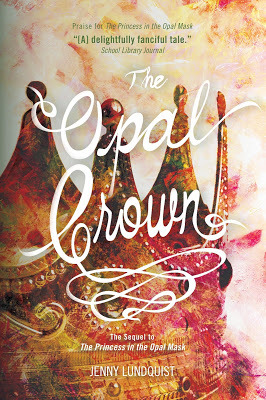
The Princess in the Opal Mask concludes with Princess Wilha choosing to give up her identity to her twin sister, Elara, who never got to experience the pleasures of royal life. In her final letter to Elara, Wilha claimed that she was going to "disappear" to give Elara the freedom and space she needed to be a true princess. This was a bit frustrating as a reader because Wilha had already built a new life for herself as a peasant and found a new family among the residents of a small village. It seemed like a shame for her to give all of that up when she worked so hard for it. In The Opal Crown, we learn that she did not stay true to her word to "disappear" and continues her position as a seamstress among her new friends at the inn. That is all well and good, but it causes problems for Elara, who married a prince under false pretenses and must wear Wilha's confining opal mask so that no one will notice she has a lookalike in town. It seems like an impossible situation. Anything that benefits one princess will harm the other.
The twins' new lives are interrupted early on when they are summoned back to their home kingdom by their brother, Andrei, who has been crowned king after the passing of their father. This creates a series of political schemes among the small handful of lords who are aware of the princesses' identities. Elara is taken into hiding, where one lord grooms her for a coup to steal the crown from her brother, while Wilha is brought to the castle where she must face the lord who attempted to murder her in the first book. Both princesses must find ways to communicate with each other to untangle the political schemes they are wrapped up in while trying to hide their connection from the wicked lord and the general public. In the process. Elara learns that she has a dark side that thirsts for power that she must learn to control, and Wilha realizes that she could do more good with the crown than she initially thought. They also attempt to speak to Andrei in secret to find out whether or not he is on their side and argue over how much of a role he plays in the kingdom's politics now that he is king.
The royal siblings have enough going on in their lives to have time to worry about romance. However, since the first book teased relationships for both girls that were left unresolved, this book helps to tie up some of those loose ends without spending a great deal of time on them. Elara finally comes clean to Prince Stefan about her true identity and must face the consequences for lying to him about who she was for the entirety of the first book. Wilha sorts out her feelings between the boy she met in the village and her swordsmanship trainer at the castle who she grew up with. It was nice to have some closure, but neither love story draws much attention away from the main plot of the book. At the end of the day, The Opal Crown is more about Elara learning to shed her gruff exterior and accept Wilha as the sister she never knew she had than it is about finding romantic love. Her relationship with her sister encompasses the true "happy ever after" of the book.
The Opal Crown should have been included as the second half of The Princess in the Opal Mask. The stories feel incomplete without each other, whereas together, they make a fantastic book. In a metaphorical sense, this is a good representation of the story's theme about how the sisters need each other to complete themselves. Elara is worldly and secretive, while Wilha is honest and humble. When the twins are united, they lend each other their strengths and become unstoppable. The Opal Crown is stronger overall due to faster pacing, sharper writing, and a more specific direction for the plot. I recommend reading both of these books in succession to fully grasp the author's vision.
January 8, 2021
Review: Bridgerton
Bridgerton was a surprise for me this month. I was unfamiliar with the Julia Quinn historical romance novels or the development of the eight-episode series on Netflix. Due to my fascination with princess fashion, this series was an easy sell. Like Reign, the show is bursting with colorful visuals of noble women dancing in glittering gowns and tiaras. It was a feast for the eyes with regal ladies, handsome lords, and bright colors reminiscent of gardens in springtime. The Regency era was a period of excessive romance and courting, which gives it the feel of a classic Disney Princess universe. The well-earned mature rating on the series, however, is not reminiscent of Disney at all. Like most direct-to-streaming live-action shows, the second half of Bridgerton has an abundance of mature content that is not appropriate for minors.
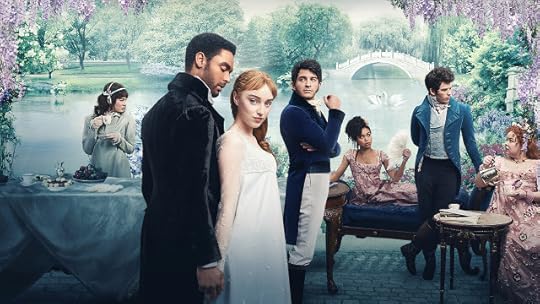
Daphne is essentially the princess of the Bridgerton family. She is a noble lady, but she fits all the tropes of a Disney Princess. She is innocent, kind, headstrong, and sincere. She even has a "Cinderella" inspired color palette with dresses in white, silver, and powder blue, which bring out her natural beauty and cause her to stand out from the bright colors and overbearing accessories adorning the other regal ladies in the show, particularly the Featheringtons. Daphne's innocence does not last long, as a lot happens over the course of these eight hours of episodes. After Queen Charlotte praises her for her flawless presentation, a ritual that was common for noble ladies during the Regency era, Daphne awaits a selection of suitors to court her. Unfortunately, her overbearing brother scares them all away, forcing her to pretend to be in a relationship with a handsome duke named Simon in the hopes that it would bring her more suitors. We all know this common Hallmark movie trope. A girl pretends to be in a relationship to win over another guy but falls for the "fake" relationship instead. As predictable as it was, I appreciate that Netflix did not try to string us along when we all knew that Daphne was not going to accept the proposal of a foreign prince. She marries Simon by the time season is barely halfway over.
For me, the first few episodes of Bridgerton were the most engaging. I enjoyed watching Daphne and Simon's unusual courtship as well as the lovely balls she attended for the courting season. The costume designers on this show went all out, giving each lady a multitude of tiaras and glittering gowns embroidered with flowers and bright colors. Regency era dresses have empire waistlines, which are flattering for just about any body type, making each dance a spectacle to behold. I am no history expert, but this show created a fantasy image of exactly how I would picture a Regency era courtship ball to look. Even the outdoor scenes were brightly lit and filled with pleasant imagery of parasols, gardens, and gowns. In contrast, the duke's world is much darker than Daphne's pastel-colored dreamland. The first few episodes are interspersed with flashbacks of his traumatic childhood. This dichotomy foreshadows Daphne's loss of innocence after her world joins with Simon's in matrimony.
The second half of Bridgerton focuses on some of the questionable aspects of the Regency era, particularly that women were left ignorant about sex in the hopes that they would remain chaste until they are married. This affects Daphne after Simon tells her that he cannot have children and uses the "pull out" method during their post marital relations without her knowledge. Just before her wedding, Daphne's mother fails miserably to have the "birds and the bees" talk with her, something that she resents her for later. Innocence is one of the most appealing aspects of fairy tale princesses for me, but I don't think that needs to come with a complete lack of knowledge. As the show points out, making women ignorant is different from keeping them innocent. One is usually harmful, while the other can be charming. I appreciate this deconstruction of social customs, but at the same time, it took away some of the whimsy and mystery that the show's world created. With only eight episodes to tell such a complex story, it progressed a mile a minute, making me wish I could have remained as innocent as Daphne was when she was being courted.
Bridgerton is a visual feast for fans of fashion, princesses, and fairy tales. It features an idealized version of the Regency era with costumes that are stunning and over the top. At its core is a complicated love story that studies loss of innocence and makes us question whether innocence is caused by ignorance or lack of experience. The show features struggles of several other women who were also victims of their time period, such as Marina Thompson, who spends most of the series attempting to rush into a marriage while hiding her pregnancy. It was narrated by the recognizable voice of , who plays a mystery character that publishes gossip amongst the ladies of court, who Daphne's sister spends a good deal of time and energy attempting to unmask. If you are looking for a romantic and colorful world with a dark underbelly, Bridgerton is the perfect binge for you. However, if you are underage or uncomfortable with mature content, it may be best to look elsewhere.
January 3, 2021
Review: Tangled in Time - The Burning Queen
My recent interest in Tudor history with The Spanish Princess and Six the Musical inspired me to read the second book in Kathryn Lasky's Tangled in Time duology. If you forgot or missed my previous review, this limited series is about a middle school girl named Rose Ashley who copes with the death of her mother by traveling back in time through a magical rose in her grandmother's greenhouse to the era of a young Queen Elizabeth. The first book, The Portal, was satisfying enough that I didn't feel obligated to read the next one. However, there were a few loose ends that I was curious about, so I decided to complete the series with The Burning Queen. I was disappointed to learn that this book was very similar to the first one and offered almost no progression in Rose's quest to rebuild her family. This post will contain some spoilers for Tangled in Time: The Portal, so please read my review for that instead if you don't want to be spoiled.
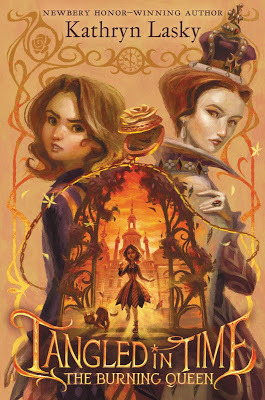
The Burning Queen picks up where The Portal left off, when Mary Tudor, the daughter of King Henry VIII and Queen Catherine of Aragon, is crowned queen for her short-lived reign. Renowned in history as Bloody Mary, the new queen spares no time in sentencing everyone who does not follow her religion to burn at the stake. On a personal note, I never understood the division between Catholics and Protestants. While there are different levels of Judaism like reform, conservative, orthodox, and Hasidic, we would never accuse someone else of having the wrong type of Jewish beliefs. I find it weird and confusing that some Christians think that their Christian beliefs are superior to other Christian beliefs. Anyway, this new regime means trouble for Rose, who is not particularly religious in any respect. Her father urges her to return to her own time, where she will be safe. Rose can't bring herself to stay away from him forever after the tragic loss of her mother, so she disobeys his order and continues to travel back and forth between the past and the present time periods just like in the first book.
My biggest disappointment with The Burning Queen is the complete lack of effort that Rose puts into her goal of getting her father, Nicholas, to come back to her own time with her. In The Portal, Nicholas agrees to try to find a way to return to Rose's time period with her so she would no longer have to be an orphan in the present day being raised by a senile grandmother. Yet, every time she brings it up in The Burning Queen, he comes up with some sort of excuse as to why he wouldn't be able to make it in our time as though living with the benefits of technology without the fear of being burned at the stake if you say the wrong thing is so unappealing. Rose even suggests in the previous book that he could continue his profession as a goldsmith in modern times and that she would do everything she can to help him acclimate. Yet, this discussion gets glazed over time and again in the sequel until it ends with a feeling of complete dissatisfaction.
This book is a rare case where it would be more enjoyable if you have not read the prequel first. It reintroduces the same creative concept of a modern girl traveling back in time and blogging about historical fashions. It gives a peek at what it would be like for someone from this time period to live as a servant to royalty during the Renassiance. It also continues the message of helping those in need when Rose convinces her grandmother to sponsor a girl at her school who falls upon trouble due to her immigration status. What it does not do is expand upon any of the unanswered questions from the other book. Rose finds that people from the 16th century mysteriously remember her being there during multiple year-long absences when she returns to her own time period. This might be more believable if she wasn't given such an important profession. Sometimes, characters reference dresses she made or tailored for Mary or Elizabeth during her absences. If she wasn't present during these time periods, where did those dresses come from, and how did they get fixed? I had hoped that the author would have had more time to think about this in the sequel, but it seems I was wrong.
Overall, The Burning Queen feels like nothing more than a rewrite of The Portal. If this was the route the author was planning to take all along, Tangled in Time should have been a single book, whether it was about Princess Elizabeth or Queen Mary. I appreciate that Kathryn Lasky wanted multiple books to show off her wealth of historical knowledge to children, but she seemed to forget about her protagonist in the process. Rose Ashley is a lonely girl who just wants a capable parent to take care of her. It isn't right to string her along for an entire sequel without at least having her try to fulfill that goal. I would only recommend this book if you have not read the first one and think the concept sounds intriguing. For anyone who wants closure to The Portal, The Burning Queen is a burning disappointment.
December 30, 2020
Review: Dress Up! Time Princess - Romy and Julius Visual Novel
In a little under two grueling weeks, I managed to complete the latest visual novel in Dress up! Time Princess, Romy and Julius, a reimagining of Shakespeare's classic, Romeo and Juliet. Every time I start a new story, I think it will be because I've gathered so many items from the previous stories, and every time, the game proves me wrong. I was overwhelmed by the difficulty level in this book. At least it was more consistent than Helen of Sparta, which was easy at first and then suddenly got super hard at the end. Two levels in Romy and Julius required a pink set with a gown, headdress, and loads of accessories that were so difficult to obtain that you can forget about completing the story until you've collected every piece from the set. The story is the strongest of the three that were released since I began playing this game. It is a unique take on a beloved classic with several satisfying endings.
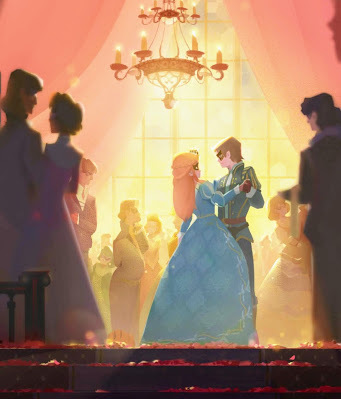
As the title implies, you play this story as Romy Montague, a noble lady who falls for a young man named Julius from the rivaling Capulet family. At first, I thought it was silly for the writers to gender bend Romeo and Juliet. Switching which of the rivaling families the two ill-fated lovers come from doesn't make nearly as much of a difference as making the prince from Swan Lake the one who turns into a swan or the princess in "Aladdin" the one who finds the lamp in. Once I got further into the story, I gained a better understanding of why they did this. Romy and Julius are descendants from the families of the original Romeo and Juliet, who suffered their tragedy two hundred years earlier. I thought this was a clever idea that grants the potential for a happy ending without being disrespectful to the original work. Taylor Swift would approve. Depending on which of the love interests you pick, this book has one bad ending, two good endings, and two bittersweet endings.
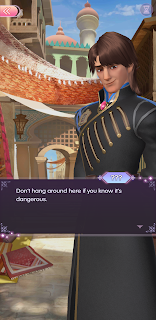
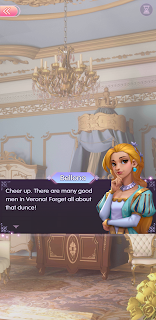
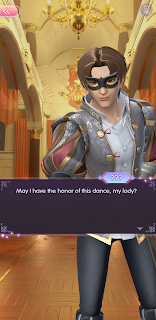
Unlike with Helen of Sparta, the decisions you must make to romance Julius or Laurence count toward the story's ending in every single chapter, so choose carefully. Friar Laurence was a character who did not make much of an impression on me in the original play, but he plays a bigger part in this version as one of the two potential love interests for Romy. He was friends with her since childhood, and if you so choose, that friendship could blossom into something more. On the other hand, Julius looks and acts just how you would expect a character inspired by Romeo to. As the story goes on, however, it is revealed that he is not quite as innocent as he appears to be. In fact, most characters in this story are harboring some sort of secret, adding suspense and intrigue that the previous two visual novel lacked. Even Romy's innocuous best friend, Bellona, a gender-bent version of Mercutio, is withholding a thing or two from her bestie. There was something new buried among the streets of Verona just waiting to be discovered around every turn.
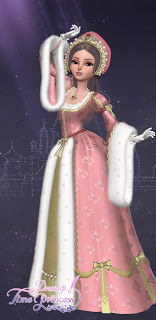
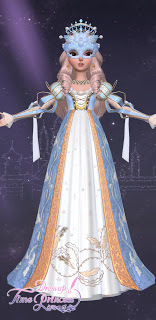
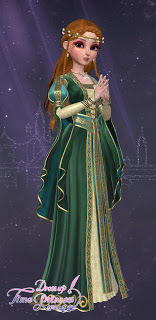
The costumes in this story are exactly what I would expect to see when I think of Shakespeare. The regal Renaissance dresses are trimmed with shimmering golden accents and sport puffed dual-colored sleeves over the shoulders. The dresses are not as stunning as the butterfly and goddess looks from Helen of Sparta, but they are still beautiful. Romy's outfits contribute a generous amount of new tiaras to the game's wardrobe, including a tall sapphire crown from her masquerade dress that reminds me of Anastasia. The dresses take a long time to complete, but the game rewards you with jewels when you do, which is more valuable than the gold currency it gives for other outfits. I had the most trouble completing the pink dress, which was necessary to unlock a required item to reach Julius's ending. I checked the in-game shop every four hours for a week before the shoes finally became available for me to purchase.
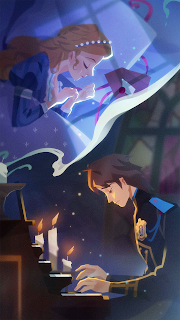
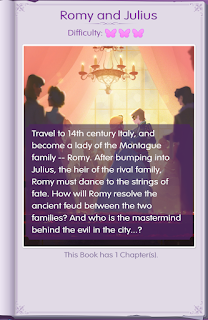
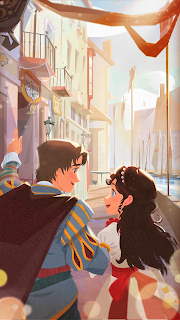
Overall, this visual novel is a vast improvement over the previous two books that were released in Dress up! Time Princess. It places a new twist on an old story and adds a layer depth and intrigue to each character. For the first time since Gotham Memoirs, the love interests felt fully fleshed out, and I was eager to get to know them better. The only thing I found a little annoying was having to go back and change almost every single decision when I wanted to switch between Laurence and Julius's endings. If you don't pick one love interest and stick with him the entire time in this story, you get the bad ending. I hope that the developers of Dress up! Time Princess continue to incorporate the same level of quality into their future stories. I've seen hints that they might do a retelling of "The Little Mermaid,", so I'm particularly excited for that!
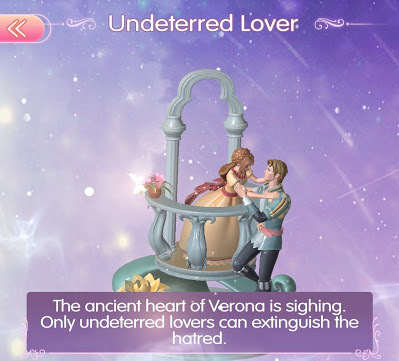
December 27, 2020
Review: The Princess in the Opal Mask
I received The Princess in the Opal Mask as a gift along with The Princess Curse. Of the two books, this one was far superior. It is yet another retelling of The Princess and the Pauper, which seems to be a popular trope these days, especially among movies. It works surprisingly well in book format, as it allows readers to switch between the perspectives of both main characters. We all know the story of two girls who discover they look alike and decide to switch lives for a few days. However, this was a refreshing break from the standard "princess meets someone who looks just like her and decides she wants a vacation" format. This book goes deeper than that by exploring themes like identity, family, and self-fulfillment. After a few slow opening chapters, it picks up with an exciting investigation that tests both girls to their limits.
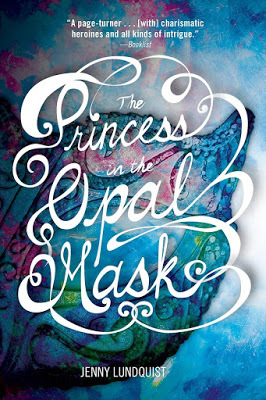
Princess Wilha has been forced to cover her face with a bejeweled mask for as long as she can remember, never knowing why. The glittering mask allows her to hide her insecure demeanor behind a submissive smile as she struggles to find her own identity. The people worship her as the masked princess, but in truth, they know nothing about who she truly is, not even what she looks like. Meanwhile, Elara is an orphan who is stuck with a cold-hearted caretaker who takes advantage of every opportunity to tell her that her parents didn't care about her enough to give her a name. She is certain that if she finds her true family, she will be able to recover her lost identity. Little does she know that the loving family she dreams of is very different from the one she was born into. Both girls trudge through the same mundane routines until one day, Wilha learns that her father has arranged for her to marry the prince of an enemy kingdom, and Elara is kidnapped and brought to the palace with no explanation. When the two girls see each other for the first time, they realize that they share the same face.
Once the princess and the pauper switch places, the book gets so exciting that it becomes difficult to put down. I wish this event had taken place earlier, as the first few chapters are rather slow. After they learn the secret behind the mask, Wilha and Elara are shipped away to the rivaling kingdom for Wilha to meet her new fiancé. Or is it Elara's new fiancé? It becomes convoluted at what point they are supposed to switch places and what point they are doing it by choice. However, each girl finds happiness and a sense of identity in the other's shoes. Wilha learns to make a living for herself outside the confines of the palace walls, and Elara learns to trust people after being mistreated her entire life. Due to her circumstances, that trust must unfortunately come in the form of a lie when she poses as the masked princess. For that reason, the romantic relationship between Elara and the prince was not as fulfilling as I hoped. Meanwhile, Wilha finds a new family when she poses as a seamstress, but she never reveals the truth to them either, and it is unclear whether or not she keeps in touch with them after the book ends.
I enjoyed this book overall, but it felt unbalanced. There was too much exposition at the beginning and not enough at the end. Elara is a jaded cynic who is reluctant to get to know Wilha. Though she grows a little, she never reaches the level of trust that I was hoping for with Wilha or the prince. I would have loved to see more growth in her relationship with Wilha, especially after how hard Wilha tried to be friends with her. Wilha has a few romantic prospects who seemed to genuinely care for her, but neither of them amounts to a satisfying relationship by the end of the book. I was so engrossed with the story by the time I reached the final chapter, that I found myself saying "That's it?" This is the type of book that needs an epilog to be fully satisfying. Before I finish nitpicking, I also want to point out how annoyed I was by the line "The mask covered my entire face, except for my chin, lips, the sides of my cheeks, and the top of my nose." That is half of your face, Wilha. There's no need to overcomplicate it.
The Princess in the Opal Mask is a refreshing take on the gender-bent "Prince and the Pauper" trope. Instead of the two doppelgangers switching places by choice, they are forced to do so and discover their true selves in the process. This isn't the first time I've read a story told that way, but the addition of the mask and the surprise ending gives it that extra something special that makes it worth reading. My only criticism is that the ending was not as satisfying as it could have been. If I could have my cake and eat it too, I would cut out the first few chapters and tack a few more on the end just to see how Elara and Wilha ended up after their unusual situation completed its course. As it stands now, I think I would rather enjoy reading a sequel. There is so much left to be explored in the lives of these two lovely heroines.
December 21, 2020
These Videos Will Make You Miss Broadway Like Crazy!
Covid took away many once-in-a-lifetime experiences from millions of people worldwide. I was content being locked away in my tower binging princess shows, but the one thing I missed the most this year was musical theater. The stage is a place for princesses to shine as they show off their stunning costumes, bell-like voices, and whimsical stories. Throughout the year, I learned about many new princess musicals that I would have loved to see if the theaters had not shut down. Streaming musicals has become more commonplace than ever, but watching a show on a screen simply cannot compare to the magic of seeing it live. While Hollywood continues to rehash old ideas, Broadway is giving us a fresh perspective on history with shows like Hamilton and Six. In the same way that Hamilton sets American history to contemporary music, Six takes the wives of Henry VIII and turns them into a pop band that performs Spice Girls-inspired numbers about their tragic lives from the middle ages.
I learned about Six right after I had finished Starz Network's The Spanish Princess, which tells the story of Catherine of Aragon. Catherine is featured in Six alongside Anne Boleyn, Jane Seymore, Anna of Cleves, Katherine Howard, and Cathrine Parr, the other five women Kng Henry VIII married in his obsessive attempts to gain a male heir. The color-coded costumes of the six ex-wives are a combination of old and new fashion with their puffy sleeves, short skirts, and way too many rhinestones. The show opens with a "Cell Block Tango" inspired number in which the former queens introduce themselves and what they were most famous for. Then each one performs a solo where she tries to argue that she should lead the group because her story is the most tragic. It all concludes with a message of female empowerment and a catchy theme song with choreography that would look incredible on stage.
"Only You, Lonely You" is the third song released from Andrew Lloyd Webber's upcoming Cinderella musical. It is the first look we get at Prince Sebastian, who will be played by Ivano Turco, the co-star to Carrie Hope Fletcher's Cinderella. It's so cool that both leads in the show have curly hair! Andrew Lloyd Webber insinuated on an Instagram post that Sebastian was not born as the crown prince. He is the brother of Prince Charming, who is absent for at least the first act of this show "doing daring deeds and probably slaying a few dragons." Due to his absence, Sebastian is the one who will now inherit the throne of Belleville. Andrew Lloyd Webber stated in another interview that Sebastian and Cinderella were childhood friends, and this song is about Sebastian's realization that he cares for her as more than a friend. I wonder how Cinderella was able to befriend a prince while she was stuck at home doing chores. It looks like this is Andrew Lloyd Webber's attempt to fix the common complaint that Cinderella doesn't spend enough time with the prince before she marries him.
The final new musical that couldn't make it through the pandemic is Diana: A True Musical Story, which tells the story of Diana, Princess of Wales, who was beloved by her people until her tragic death in 1997. Like Six, this show was rudely interrupted from its Broadway previews when the great white way went dark in March just before its official opening. This beautiful video portrays Jeanna de Waal performing the song "If," in which Diana sings about her innermost hopes and dreams for her new life as a princess. Diana has a leg up over the other two shows on this list because it has a professional recording ready to stream on Netflix in early 2021. The official website states that Netflix will stream the show before it is set to reopen on May 25, 2021. It's smart for them to have a backup plan after so many princess movies got rescheduled this year and wound up going direct to streaming anyway.
It took a long time for the cabin fever of 2020 to set in for me. I was pretty content staying home, reading, and playing games, but like many princesses, I love singing and musical theater. Learning about these musicals reminded me of the rush I got in college when I hop on a bus to Broadway and watch the lights dim as the stage came to life and transported me to another world of flashy costumes, energetic choreography, and passionate music. I eagerly await the day that these shows will return to theaters again so I can escape my tower and see them in person.
December 20, 2020
Review: The Princess Curse
My friend sent me The Princess Curse by Merrie Haskell after letting me know that she didn't care for it quite enough to keep. Frankly, I can understand why. It fascinates me how many well-written family-friendly princess books there are out there by indie authors when a famous publisher like Harper Collins would release a questionable book like this one through their children's market. I got the impression that the author wanted to write a princess story for adults, but the mainstream media likes to follow the misconception that anything involving fairy tales is solely for children, so they forced her to age down her protagonist and water down the story. Doing so turned the whole thing into a big mess of an adaptation suffering from a severe identity crisis.
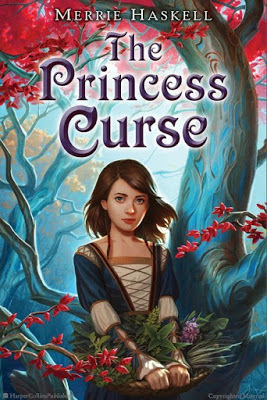
The Princess Curse is an adaptation of "The Twelve Dancing Princesses" and "Beauty and the Beast." Right off the bat, it loses points for doing exactly what every other author who wrote an adaptation of "The Twelve Dancing Princesses" has done. Merrie Haskell turns the fantastical underground world of silver trees and handsome princes into an inescapable hell that the princesses need to be rescued from. "The Twelve Dancing Princesses" was one of my favorite fairy tales as a child, and I can tell you right now that it was not because I wanted the princesses to find a way out of the enchanting land that they run off to each night to escape their mundane royal duties. I'm not sure if every author who does this is copying the others or if they truly believe that they are being original and edgy. Turning the dancing into a curse instead of a nightly opportunity for freedom makes the story less empowering for girls reading it because it turns the heroines from tenacious sisters who guide each other toward freedom into traditional damsels in distress.
Merrie Haskell did not want to give her readers a damsel in distress as a role model, so the protagonist is not one of the princesses, but an herbalist's apprentice named Reveka who works in the castle. The story is told from Reveka's perspective, but she makes no sense to me. She is a thirteen-year-old girl, who acts like a middle-aged woman. Reveka becomes the princesses' savior by agreeing to marry a dragon-like being called a zmeu who held them captive every night in the underworld. She does this in spite of her desire to spend the rest of her unmarried life in a convent, a decision that she is probably too young to make. After she marries Dragos, the words "child bride" come up a lot. He even makes a point of telling her that she is too young to consummate the marriage. For some reason, HarperCollins decided that in spite of that, this book is A-OK to publish under their children's subsidy. Good job looking out, guys.
Due to Reveka's age and the fact that this book is written for children, she develops an awkward relationship with Dragos that qualifies as neither friendship nor romance. With the "Beauty and the Beast" inspiration behind the book, it's supposed to be implied that she would grow to love him over time, but we don't see that time in the context of this story. I think The Princess Curse would have been fine if had been written for adults (which I suspect was the author's original intention). Due to the aged down protagonist and unnecessarily complex world, something got lost in translation. Not only does the author try to combine two fairy tales, but she also crams Greek mythology and real-world history into this single book. The Princess Curse is a prime example of too many cooks in the kitchen.
I felt like I was reading this book out of obligation and not enjoyment. It's a mess of a story that is never certain what it wants to be. It doesn't have a kid-friendly, but it was published for children. It isn't a love story, but it is about a child bride who is meant to love her captor. It doesn't contain Greek gods or goddesses, but it incorporates Greek myths. It has "princess" in the title, but none of the princesses in the book are particularly likable, and the main character becomes a queen--not a princess--but marrying the dragon. If this is the type of fairy book that professional publishers find marketable these days, I will continue to stick to indie authors; thank you very much.
December 18, 2020
Disenchantment Part 3? Yes, Please!
It's been a rough year. Not only did three animated princess shows end, but it's been over a year since we got new episodes of Disenchantment. We need Matt Groening's dark humor now more than ever, so I am pleased to announce that it will only be a matter of weeks before Princess Tiabeanie makes her return to Netflix. A new trailer was just released, and oh my goodness! There is an incredible amount of footage packed into this two-minute treat of a teaser! Mermaids, world-building, and familiar faces abound as Bean must decide if she wants to form an alliance between the kingdoms of Dreamland and Steamland. Part 3 of Disenchantment will hit Netflix on January 15th, 2021. You can check out the trailer below.
The second season of Disenchantment ended with a surprise re-appearance of Bean's mother, Queen Dagmar, a fascinating villain who was notably absent for most of the season. It looks like the next part will place more focus on her half-hearted attempts to reconcile with Bean as Bean continues to regret her decision to ever bring her wicked mother back to life. I would love to see more dysfunctional mother-daughter moments in the new season, as I felt the previous seasons were lacking in this respect. What sets Bean's relationship with her mother apart is that in other fairy tales, it's usually the stepmother who is evil, while the kind-hearted mother figure is long gone, often due to a tragedy from the princess's childhood. This show does a deconstruction of that trope by giving Bean a stepmother who appears evil at first but turns out not to be so bad after all. Just as any other princess would, Bean jumps at the chance to bring back her deceased mother and is shocked to learn that the loving mother she imagined was very different from the person she brought back, which can act as an allegory for how we remember people who are gone.
Another story arc teased in the trailer is a return to Steamland, the steampunk-inspired kingdom that Bean visited in the last season. Her status as a princess has more relevance to this visit as she is faced with the possibility of an alliance between the two kingdoms that would combine the magic of Dreamland with the science of Steamland. This is such a neat idea that I'm surprised it has never been done before. What sort of fresh disaster will Bean create by trying to blend together magic and technology? We see her royal status come into play more than ever here as her citizens praise her as their queen while she looks over them in a gorgeous royal blue off-the-shoulder gown. Hopefully, this doesn't mean that something happened to King Zog for the crown to be passed down, but this show has brought so many characters back from the dead that it probably wouldn't mean that much anyway. I'm looking forward to a more dramatic storyline that takes more of Bean's relationships and nobility into account instead of a bunch of filler gag episodes.
I was also excited to see hints of a mermaid episode in the preview. It's no secret that I love mermaids, so to see Bean hanging out with them for a full episode would be heavenly. The mermaids appear to help Bean escape her situation as she gleefully follows them through the sea to some sort of desert island where they share cocktails. It would be great to see Bean form some sort of relationship with the blue-haired mermaid so that she could become a recurring character on the show. There's already an elf sidekick, so why not a mermaid too? Speaking of sidekicks, it doesn't look like Bean's inner demon, Luci, has a lot to do in these clips. Maybe they're trying to avoid spoilers, or maybe Luci hit his peak in the Hell arc from the second season. There isn't much more character growth he could get after sacrificing the opportunity to become an all-powerful demon to save his friends.
With the year we've had, we could all use a little more zaniness in our lives. The first two seasons of Disenchantment were mildly disappointing, but I have my hopes up that this will be the best one yet. I'm looking forward to seeing more of Queen Dagmar and watching Bean grow from a lazy drunkard into a mature young queen. I'm also intrigued by all of the new fantasy elements that were teased including the mermaids and the mystical properties of Dreamland that provoked Steamland into forming an alliance. I'm sure there will probably be a few silly filler episodes too, but hopefully not as many. We'll find out when the third part of Disenchantment premieres on January 15th, one month from today, on Netflix.
December 13, 2020
The Nutcracker Prince Is the Best Nutcracker Movie You've Never Seen!
The holiday season has begun, but like many other things this year, it is a mere shadow of its former self. That's why I was so pleased when one of my readers referred me to an animated version of "The Nutcracker" that I had missed during my childhood. The Nutcracker Prince is by far the most accurate version of E.T.A. Hoffmann's "The Nutcracker and the Mouse King" that I have ever seen. After my overwhelming disappointment with Disney's The Nutcracker and the Four Realms, I thought that the Barbie movie was the closest I'd ever get to an accurate feature based on this classic fairy tale. I was wrong. The Nutcracker Prince is an animated film released in 1990 with a surprisingly impressive cast of voice talent. Sadly, there's no chance of seeing it on Disney+ any time soon because it was distributed by Warner Brothers, one of the only major film studios that Disney does not own (yet). However, it is free to watch on YouTube for those of you in need of some holiday princess cheer.
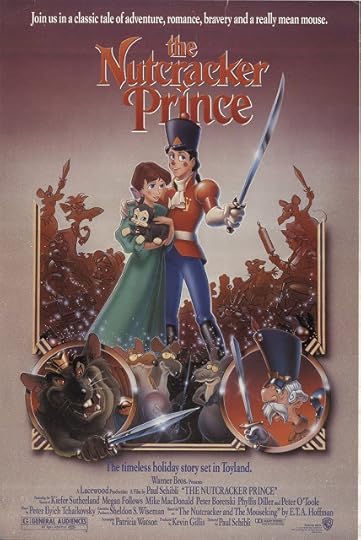
The first thing I noticed about this movie is that the character designs are reminiscent of Anastasia , one of my personal favorites. Clara looks like a younger version of the redheaded Russian heroine with a similar hairstyle to the scene where Anya danced with Dimitri for the first time. The quality of the animation was not quite as good as Anastasia, of course, as there are few movies that have the same intricate shading and attention to detail as Don Bluth's masterpiece. However, there were still details that impressed me, such as the brilliant sparkle of Clara's mother's necklace when received it as a Christmas present and the attention to detail on the Nutcracker doll's transformation into a human/doll hybrid after he came to life. I was also impressed by the whimsical artistic style when Drosselmeyer tells the story of Princess Pirlipat. There is a clear shift in animation between the "real" world and the magical kingdom inhabited by a comedic king and queen with two wicked royal mice. The backgrounds and character designs during this scene were reminiscent of Mary Blair's art and looked like they came straight out of Alice in Wonderland .
I was also impressed by how respectful The Nutcracker Prince is to both the E.T.A. Hoffmann tale and the Tchaikovsky ballet. It seemed like they didn't miss a single detail. They kept the famous name "Clara" from the ballet, but gave the name "Marie" from the fairy tale to Clara's doll as a tribute. The method that Clara uses to save the Nutcracker by throwing her shoe at the Mouse King was spot on with the original story. So many other versions of this tale exclude the section about Princess Pirlipat entirely since her story is such a drastic segue from Clara's tale. I liked that this version accounted for that tonal shift by giving Pirlipat's world a different animation style to portray the disconnect between the two stories. Even the Kingdom of the Dolls at the end of the movie had its own intricate design with bright colors and enhanced details. The Disney version tried to do something similar by designing four distinct realms, but they had already butchered the story and let their beautiful set designs go to waste.
I loved that this version added lyrics to the famous Tchaikovsky "Nutcracker Suite." It was so cute and unexpected to see Clara dance around with the Nutcracker to this famous song. As far as I know, the only other movie to add lyrics to a Tchaikovsky song was Disney's Sleeping Beauty. Hearing this classic score throughout the movie really enhanced Hoffmann's fairy tale with whimsical art that the ballet would not have been able to incorporate. I wish I had known about this version of the story when I was younger because it would have surely been my favorite. The artwork, the characters, and the music were done so well that it's a shame it never got the attention it deserved. If you were as disappointed as I was with The Nutcracker and the Four Realms, The Nutcracker Prince is the perfect alternative.
If you are looking for something pretty and cheerful to get into the right mood this holiday season, look no further than The Nutcracker Prince. This classic story has never been portrayed quite as accurately and creatively as it was in this 1990 film, when animation was at its peak. If this movie leaves you craving an opportunity to somehow magically transport yourself to a theater to see the ballet during the lockdown, you are in luck. The New Paltz Ballet Theater will be streaming a live performance of it on YouTube starting November 24th. It will be available until New Year's Day, so don't miss your chance to enjoy this holiday princess classic! Happy holidays, everyone!



